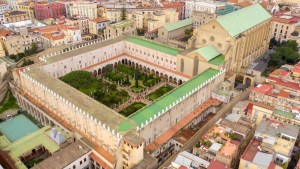The Norbertines of St. Michael’s Abbey have been releasing some wonderful videos that highlight the beautiful traditions of monastic life. Simply leading by example, these priests and friars continue to produce encouraging content that reflects the beauty of religious life.
In 2023, some of the singers from their community got together to record this rendition of “Hortus Conclusus Est,” composed by their very own Fr. Frederick Schmit, O.Praem. The lyrics were drawn from the Song of Songs, a biblical text that celebrates the love between man and woman, written from the perspectives of the lovers.
Fr. Schmit broke down the theology of the text in a paper that was released in tandem with the hymn. He explained that this antiphon came from the Divine Office of the Immaculate Conception:
“We chant these words to the Blessed Virgin, addressing her as hortus conclusus, an ‘enclosed garden.’ This phrase originally comes from the Scriptures, namely from the Song of Songs. The Church has taken these sacred words and applied [them] to the Blessed Virgin.”
While on the surface, the Song of Songs is a love poem between two who are smitten with each other, as “a divinely inspired book of the Scriptures,” there is a subtext that belies the human romance: that of God’s love.
Fr. Schmit notes that many saints and scholars have identified “three mystical relations” that the Song of Songs describes:
“The relation between Christ and the Church; between Christ and the soul; and specifically between Christ and the Blessed Virgin Mary.”
Of course, God’s love extends to all of his creation, but Fr. Schmit writes that he is especially occupied with the Blessed Virgin, as is evidenced by how Mary was preserved “from all stain of sin” and bestowed with “the grace to be immaculately conceived.”
“Mary is an enclosed garden because of her perpetual virginity… The garden of Mary’s womb was thus only accessible by Almighty God and was closed off to all others. Mary is a paradisiacal garden—a new sort of Eden—reserved for God alone, and the fruit of her womb—a new sort of Tree of Life—is the incarnate Son of God himself.”
The composer priest mused that the “Hortus Conclusus Est” is sung “in the very expressions of love uttered by God himself in the Song of Songs” and it can be heard in the robust, jubilant performance of the video, featured above.
Hear more from the singers at St. Michael’s Abbey, and explore a plethora of beautifully shot videos that promote and explain religious life to those who may be curious or identifying their own vocation, at the YouTube channel of St. Michael’s Abbey.
Learn more about the community at The Abbot’s Circle.




